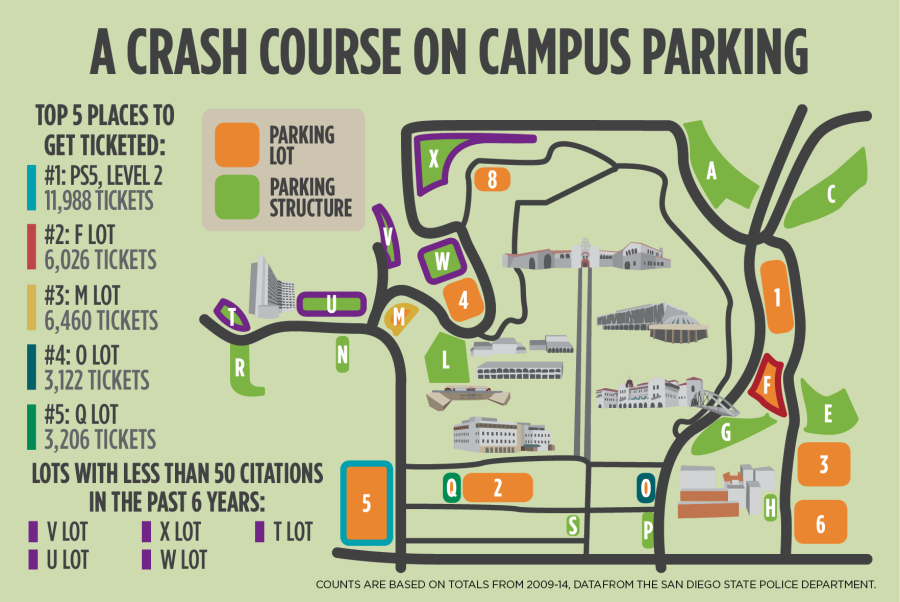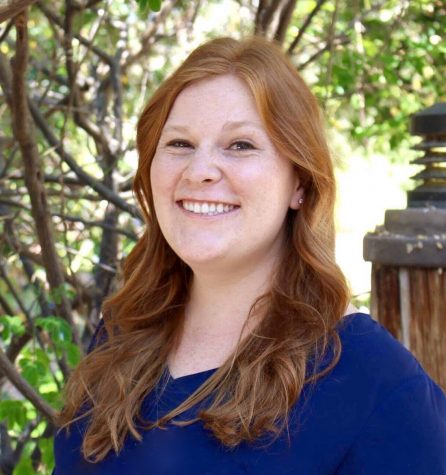Parking at San Diego State can be a stressful experience for some Aztecs. The daily difficulties of competing with thousands of others for a spot can be made even more complicated with the sporadic closure of parking structures during special events.
“I don’t know enough about the situation to propose a realistic solution,” mechanical engineering sophomore Nick Chavez said. “But I do know the closing of parking structures is not helpful for students.”
Many students like to plan their trips to campus around the times they are most likely to find parking, but with certain class schedules, that isn’t always possible. Civil engineering junior Jose Moreno-Pinete said in past years when his classes were more spread apart in the afternoon, it was difficult to find a parking spot anywhere on campus.
“Now that I have 8 a.m. classes, finding a parking spot is not a problem,” Moreno-Pinete said. “But then again, most students don’t look for parking spots at 6 a.m.”
There are also spots reserved in all structures and lots that are specifically for faculty and staff, an added stress factor according to some students.
“It’s frustrating to see levels of faculty parking in some lots that are often empty,” criminal justice junior Farah Saleh said. “I understand faculty need parking for themselves, but maybe a re-evaluation of the amount of parking that is reserved for faculty is needed.”
Data from the SDSU Police Department showed there are a total of 107,605 parking citations issued between 2009 and 2014, which breaks down to an average of about 18,000 per year. This may seem high, but during that time period, the annual amount of citations issued actually decreased by more than 50 percent.
The director of parking and support services, Debbie Richeson, said that the number of tickets was not an example of excessive ticketing by the department.
“In fact, you can see that the trend is descending over the years, we actually have low values compared to other campuses,” Richeson said. “That’s one of the things I’m going to an outside vendor for, as they said our values are low.”
Richeson hired a consulting firm, SP+, which according to their website, is an “operations specialists who link innovation with market-based expertise in our Parking, Transportation, Facility Maintenance, Event Logistics and Security service lines.”
Richeson said SP+ was on campus last week and is back this week to conduct focus groups and meet with students and faculty.
“We are having the firm come out and look at our entire operation,” Richeson said. “They will be doing peer reviews and focus groups in an attempt to move parking services into a more user-friendly, positive experience on campus.”
Richeson said the decreasing amount of traffic tickets during the six-year period is due to the increases of other job duties within the department. Giving out parking citations is not the police department’s only job anymore, so it doesn’t have as much time to focus on just that.
When asked if the campus police were required to meet a certain quota for parking citatations, Richeson said, “Absolutely not.”
Student day-use permits cost $135 per semester, and overnight permits are $213. The prices for metered areas vary between $1 to $5 per hour, or up to $5 per day for one-day permits established in accordance with California State University and campus policies.
“The most common parking violations are no-permit violations,” Richeson said.
The fee for no permit is $65, which could be reduced to $35 during an appeals process if the student shows proof of a purchased permit. The steps of the appeals process is thoroughly outlined on the SDSU police department website, which also notes, “Citations issued due to lack of knowledge, not seeing information, or receiving information from a source other than Parking Services are not grounds for dismissal.”
The top time to receive a citation was at 12 a.m. with 3,613 citations issued during the six-year period. The other top times that followed were found to be between the hours of 11 a.m. to 12 p.m. with an average of 224 citations.
“I think it’s fair to say that the trend used to be that we didn’t have officers working during the night, and maybe people felt they could get away with parking illegally and took their chances,” Richeson said. “But now since I have officers working at night, the group willing to take their chances in getting citations is obviously getting them.”
And what about locations? The top places to receive a citation were Parking Structure 5, Level 2 with a total of 11,988 citations issued on that floor of the structure during the six-year period. The other top places to receive a parking citation included the F Lot with 6,026 citations, M Lot with 6,460 citations, O Lot with 3,112 citations and Q Lot with 3,206 citations.
Richardson said this is likely because these lots have pay stations where visitors can pay by the hour, opposed to lots that are only for permit use.
“Anytime you have a pay lot with pay stations, those lots are always going to have a lot more citations as payments expire, in comparison to student lots, where the permit lasts all day.” Richeson said. “I will say that with PS5, specifically, since it’s mixed use with both pay stations and student permits, the paid tickets expiring is what is resulting in the high level of tickets in that area.”
Richeson said the top five places with the highest volume of citations issued during the last academic year, 2013-14, were PS5, Parking Structure 4, Parking Structure 3, the M lot and Parking Structure 6, but she did not include the exact values of tickets. Richeson also said that O Lot no longer exists.
And some locations came in on the other end of the spectrum, with less than 100 tickets during the entire time period. The V Lot, U Lot, X Lot, W lot and T lot all fit the criteria. (Check out the corresponding map for locations.)
“T lot is a very small lot, U Lot and V Lot are all residents that don’t really go anywhere,” Richeson said. “X Lot only fills up on Tuesdays and Thursdays because of the influx of students on campus during those days.”
Richeson said that W Lot and P Lot no longer exist, which explains the reason why the value of issued citations are so few. W Lot is currently a laydown area on the other side of PS4 that’s slated to become a field when the area is no longer needed.
Although the subject of parking at SDSU will likely still bring stress to some Aztecs, hopefully this insight into the matter will help everyone understand the situation a little more clearly. There is no clear indicator showing if the parking structure closures will increase in years to come, but if the trend continues and Aztecs remember to keep up with their permits, we can at least hope to continue to see fewer citations in the future.












